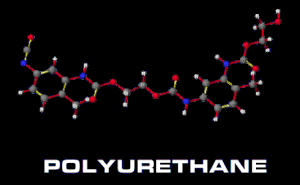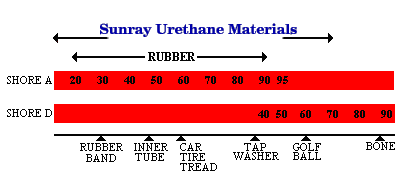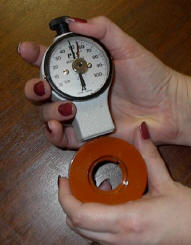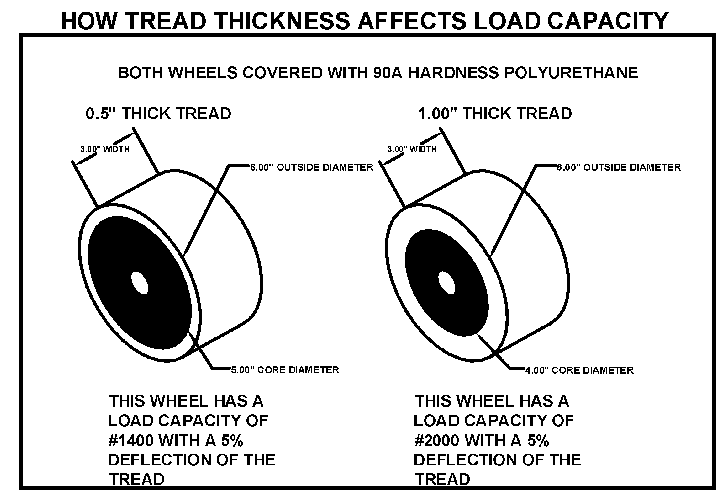
Polyurethanes are complex molecular chains that, when formed, tend to retain their shape, flexibility and resilience under stress, tension or compression. With the ability to be formed into practically any shape, size, and hardness, polyurethanes are extremely versatile. Here’s some general information on polyurethanes and how Sunray, Inc. ensures that you get high-quality polyurethane components.
Durometer (Hardness)
The hardness of polyurethane is measured using the “Durometer” scale.
The Durometer scale measures hardness in terms of the elasticity of the material. A diamond-tipped hammer in a graduated glass tube is allowed to fall from a known height on the specimen to be tested, and the hardness number depends on the height to which the hammer rebounds; the harder the material, the higher the rebound.
Durometer hardness is a measure of the resistance of material to indentation by 3 spring-loaded indenter. The higher the number, the greater the resistance.
 The hardness testing of polyurethane is most commonly measured by the Durometer test or Rockwell hardness test. Both methods measure the resistance of the material toward indentation. Both scales provide an empirical hardness value that doesn’t correlate to other properties or fundamental characteristics. Durometer Hardness, using either the Durometer A or Durometer D scale, is the preferred method for elastomers. The Durometer A scale is used for ‘softer’ polyurethanes while the Durometer D scale is used for ‘harder’ ones. The Durometer A Hardness is the relative hardness of elastic materials such as polyurethane or soft plastics can be determined with an instrument called a Durometer A durometer. If the indenter completely penetrates the sample, a reading of 0 is obtained, and if no penetration occurs, a reading of 100 results.
The hardness testing of polyurethane is most commonly measured by the Durometer test or Rockwell hardness test. Both methods measure the resistance of the material toward indentation. Both scales provide an empirical hardness value that doesn’t correlate to other properties or fundamental characteristics. Durometer Hardness, using either the Durometer A or Durometer D scale, is the preferred method for elastomers. The Durometer A scale is used for ‘softer’ polyurethanes while the Durometer D scale is used for ‘harder’ ones. The Durometer A Hardness is the relative hardness of elastic materials such as polyurethane or soft plastics can be determined with an instrument called a Durometer A durometer. If the indenter completely penetrates the sample, a reading of 0 is obtained, and if no penetration occurs, a reading of 100 results.
How Sunray Tests Polyurethane Hardness
 Hardness is measured with an apparatus known as a Durometer and consequently is also known as ‘Durometer hardness’. The hardness value is determined by the penetration of the Durometer indenter foot into the sample. Because of the resilience of polyurethanes, the hardness reading may change over time – so the indentation time is sometimes reported along with the hardness number. The ASTM test number is ASTM D2240 while the analogous ISO test method is ISO 868.
Hardness is measured with an apparatus known as a Durometer and consequently is also known as ‘Durometer hardness’. The hardness value is determined by the penetration of the Durometer indenter foot into the sample. Because of the resilience of polyurethanes, the hardness reading may change over time – so the indentation time is sometimes reported along with the hardness number. The ASTM test number is ASTM D2240 while the analogous ISO test method is ISO 868.
The results obtained from this test are a useful measure of relative resistance to indentation of various grades of polymers. However, the Durometer hardness test does not serve well as a predictor of other properties such as strength or resistance to scratches, abrasion, or wear, and should not be used alone for product design specifications.
Other Tests
Prepolymer testing assures consistency, quality and durability. Chemical analysis prior to manufacturing and strict quality control assure your parts are the finest quality and meet all your specifications. Sunray also utilizes a testing machine for wheels that subjects them to simulated work environments. Our testing includes speed testing, load testing and bond strengths to the substrate. This ensures that the wheels you receive will meet or exceed your requirements in these areas.
Wheels: Tread Thickness vs. Load Capacity

Wheels can be designed to withstand light to extreme loads. Click the magnifying glass below the image for an enlarged example of how tread thickness affects load carrying capacity.
For more information on load capacities for each size wheel, click here.
Polyester vs. Polyether
These are the two main types of polymers that Sunray, Inc. utilizes. Each offers its own performance properties. Sunray can also formulate polyurethanes to fit your particular application. Below are typical properties for both types of Polyurethane.
| Polyester | Polyether |
|
|
| They are not recommended for use in high humidity or exposure to water, as volume swell and reduction of properties may result. | Because of inherent advantages in low heat build-up, polyether-based urethanes are recommended for applications undergoing medium to high stress. |
Other Properties of Polyurethane Elastomers
Abrasion
In applications where severe wear is a problem, polyurethanes often outperform rubber, plastics, or even metals. This durability often means that a part made from polyurethane can be made with less material and weight, reduced maintenance, and lower cost.
Compression
This is an important advantage in the design of some designs, i.e., springs. In addition to high load-bearing properties in both tension and compression, urethanes have a high load-bearing capacity in shear
Mechanical Properties
At lower hardness levels, practically all elastomeric materials bend under impact. As they are compounded up to a higher degree of hardness, they tend to lose elasticity and crack under impact. However, even at their highest hardness levels, they have significantly better impact resistance than most plastics.
Resilience
Formulations are possible in a wide range of resiliencies. For very shock-absorbing uses, urethane can be made with rebound values of 10-25%. For applications requiring quick recovery, or where high-frequency vibrations are a factor, they can be made with rebound values from 40-70%.
Flexibility
Polyurethane elastomers resist cracking under repeated flexing. Since cracking under heavy flexing may be reduced by decreasing the thickness of the part, polyurethanes offer an advantage in that they can be used practically in very thin sections because of their strength.
Friction Coefficients
Polyurethanes can be formulated with coefficients of friction varying from very low, for items like bushings, bearings, or wear strips, or very high, for items like tires or rollers. For more information about the impact of coefficient of friction on polyurethane drive wheels, click here.
Temperature
Many polyurethane elastomers remain flexible at very low temperatures and possess outstanding resistance to thermal shock. The low temperature resistance of polyurethanes has led to many applications in arctic conditions.
In addition, polyurethanes can withstand sudden and dramatic temperature drops without cracking. Polyurethanes can withstand continuous use up to 90 C (194 F) with ease. Polyurethanes can be made flame resistant by incorporating flame retardants into their formulas.
Water
Polyether-based polyurethanes remain stable in water as warm as 50 C (122 F) for long periods. (They are not recommended for continuous use in water over 70 C (158 f). Water absorption is a very low .3% to 1% by weight and volume swell is negligible, enabling operation at close tolerance in water lubricated applications. Polyester-based urethanes are generally not recommended for water uses.
Other Materials
Polyurethanes resist a wider range of substances in comparison with other rubbers and plastics, making them suitable for products that come in contact with a number of substances. Formulations are available that resist mold, mildew, and fungus growth as well, making them suitable for high-humidity or tropical environments.
Electricity
Most polyurethanes have very good insulating properties and are used in many encapsulating applications.
Oxygen and Ozone
Polyurethanes that are pigmented are highly resistant to degradation by atmospheric oxygen and ozone and are immune to attack by normal atmospheric concentrations. This makes them highly successful when used around electrical equipment, without hardening or cracking. Unpigmented polyurethanes are not resistant to ozone.
Tensile Strength
Tensile stress is the force placed on the sample divided by the cross-sectional area of the sample, tensile stress, and tensile strength as well, are both measured in units of force divided by units of area. Polyurethanes can be formulated with high-resistance to stresses and they tend to maintain shape and mechanical properties after repeated stressing.
Radiation
Of all elastomers, polyurethanes have the best resistance to gamma-ray radiation.
